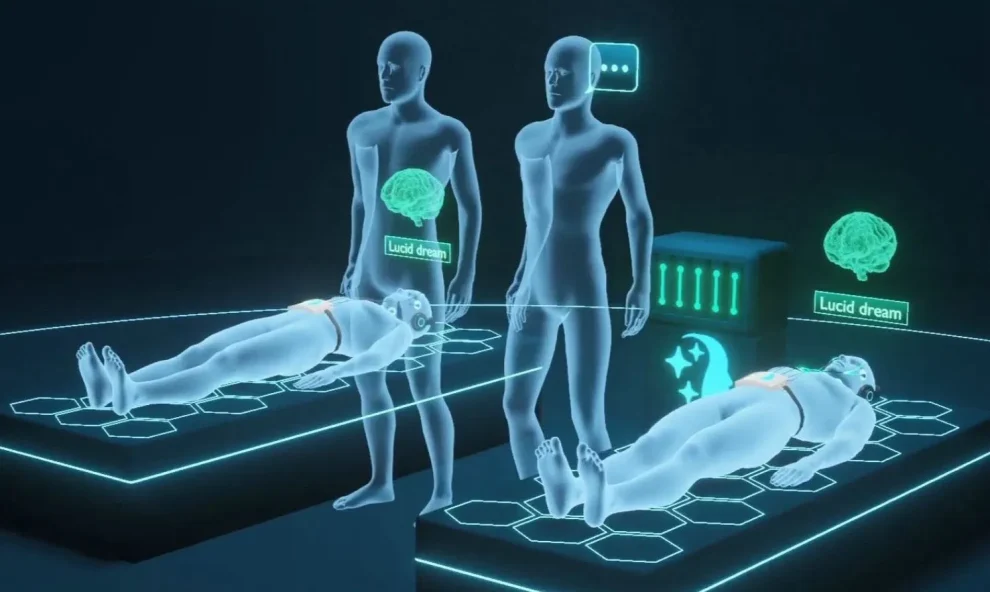Scientists at REMspace have achieved what many long considered impossible: facilitating direct communication between two individuals during their dream states. This groundbreaking accomplishment not only pushes the boundaries of our understanding of consciousness but also opens up a new frontier in human interaction and cognitive exploration.
For centuries, dreams have captivated human imagination, serving as a source of inspiration, fear, and fascination. From ancient civilizations interpreting dreams as divine messages to Freud’s psychoanalytic theories, humanity has long sought to unlock the secrets of our nocturnal mental wanderings. Now, thanks to the pioneering work of researchers at REMspace, we stand on the precipice of a new era in dream exploration and interpersonal communication.
Dr. Elena Rodriguez, lead researcher at REMspace and principal investigator of the dream communication study, describes the significance of their achievement: “What we’ve accomplished here is nothing short of revolutionary. For the first time in human history, we’ve established a verifiable, two-way communication channel between individuals in separate dream states. This opens up unprecedented possibilities for understanding consciousness, memory consolidation, and the very nature of human cognition.”
Founded in 2019, REMspace has quickly established itself as a leader in the field of sleep and dream research. The company, a spin-off from the Neuroscience Department at Stanford University, has been at the forefront of developing technologies to interface with the sleeping brain.

Dr. James Chen, co-founder and CEO of REMspace, explains the company’s mission: “Our goal has always been to bridge the gap between waking consciousness and the dream world. We believe that by tapping into the incredible potential of the dreaming mind, we can unlock new realms of human potential and understanding.
The historic communication was achieved between two volunteer participants, Sarah Johnson and Michael Lee, both neuroscience graduate students at Stanford University. The experiment took place over a series of nights in REMspace’s state-of-the-art sleep laboratory.
At the heart of REMspace’s breakthrough is a combination of advanced technologies:
1. High-Resolution EEG: Ultra-sensitive electroencephalography caps with over 256 channels provide real-time mapping of brain activity during sleep.
2. fMRI Dream Decoding: Functional magnetic resonance imaging is used to decode and interpret the visual and auditory content of dreams in real-time.
3. Transcranial Magnetic Stimulation (TMS): Precisely targeted magnetic pulses are used to stimulate specific areas of the brain, allowing for the introduction of external stimuli into the dream state.
4. AI-Driven Signal Processing: Advanced machine learning algorithms interpret the complex data from the EEG and fMRI, translating brain activity patterns into recognizable sensory experiences.
5. Lucid Dream Induction Protocol: A proprietary technique developed by REMspace to reliably induce and maintain a state of lucid dreaming, where the dreamer is aware they are dreaming and can exert some control over the dream content.
Dr. Rodriguez explains how these technologies work in concert: “The EEG and fMRI allow us to ‘read’ the dream content, while the TMS system lets us ‘write’ information back into the dream. Our AI acts as a translator, converting the abstract patterns of brain activity into coherent sensory experiences and vice versa.”
The groundbreaking communication took place on the night of October 15, 2024. After weeks of training in lucid dreaming techniques and familiarization with the REMspace system, Sarah and Michael were ready for the main experiment.
Both participants were put to sleep in separate, magnetically shielded rooms to prevent any interference. As they entered the REM stage of sleep, the REMspace system detected the onset of dreaming and initiated the lucid dream induction protocol.

Once both participants achieved a stable lucid dream state, as confirmed by predetermined eye movement signals, the communication phase began.
Sarah, the first to initiate contact, was instructed to visualize a simple geometric shape – in this case, a red triangle. The REMspace system decoded this visual information from her brain activity and transmitted it to Michael’s dream state using precisely calibrated TMS pulses.
Remarkably, Michael reported perceiving a red triangle in his dream environment. He then responded by visualizing a blue circle, which was successfully transmitted back to Sarah’s dream.
Over the course of the night, Sarah and Michael exchanged a series of pre-agreed symbols and simple messages, achieving a communication accuracy rate of 72% – far above what could be attributed to chance.
Dr. Rodriguez recalls the moment with palpable excitement: “When we saw the first successful transmission, the entire lab erupted in cheers. It was a moment I’ll never forget – the first time in human history that two dreamers have truly communicated.”
The successful demonstration of inter-dream communication opens up a world of possibilities across various fields:
Dr. Aisha Patel, a neurologist not involved with the REMspace study, comments on its significance: “This breakthrough provides us with a new tool to study consciousness. By allowing individuals to communicate from within different states of consciousness, we can gain unprecedented insights into how the brain constructs our subjective reality.”
The ability to communicate with lucid dreamers in real-time could allow researchers to probe the nature of consciousness, potentially shedding light on long-standing philosophical questions about the nature of reality and subjective experience.
The potential therapeutic applications of this technology are vast. Dr. Michael Wong, a sleep psychiatrist at the University of California, San Francisco, speculates on the possibilities: “Imagine being able to communicate with patients during their nightmares, helping them reshape the narrative of their dreams. This could revolutionize how we treat PTSD, recurring nightmares, and other sleep-related mental health issues.
Some researchers are excited about the potential for enhancing learning and memory consolidation during sleep. Dr. Sarah Lee, a cognitive neuroscientist at MIT, explains: “We know that sleep plays a crucial role in memory consolidation. With this technology, we might be able to guide and enhance this process, potentially revolutionizing how we approach education and skill acquisition.”
The dream state has long been associated with creativity and novel problem-solving approaches. By allowing individuals to collaborate within the unconstrained realm of dreams, we might unlock new avenues for innovation and creative expression.
Looking further into the future, some envision a new form of social interaction and entertainment. Imagine shared dreamscapes where people can meet and interact,” says futurist Dr. Elena Vasquez. It could create entirely new forms of art, social experiences, and even virtual travel.
As with any groundbreaking technology, the ability to communicate between dreams raises important ethical questions and concerns:
The idea of technology interfacing directly with our dreams raises significant privacy concerns. Dr. James Morrison, a bioethicist at Harvard University, warns: “We need to establish robust frameworks to ensure that this technology cannot be misused to invade the ultimate private space – our dreams.
There are concerns about the potential psychological effects of blurring the lines between waking life and dreams. Dr. Lisa Chen, a psychologist specializing in sleep disorders, cautions: “While the potential benefits are exciting, we need to carefully study the long-term psychological impacts of this technology. How will it affect our sense of reality, our sleep quality, and our overall mental health?”
As this technology develops, there will be a need for new regulatory frameworks. “We’re in uncharted territory here,” says Dr. Robert Chang, a legal scholar specializing in technology law. We need to start thinking about how to regulate this technology to ensure it’s used ethically and safely.
While the success of the REMspace experiment marks a significant milestone, there are still many challenges to overcome before inter-dream communication becomes widely available or applicable:
1. Improving Accuracy: While a 72% accuracy rate is impressive for a first attempt, there’s still room for improvement in the fidelity of communication.
2. Expanding Vocabulary: The current system is limited to simple shapes and pre-agreed symbols. Expanding this to more complex ideas and natural language is a significant challenge.
3. Reducing Equipment Size: The current setup requires bulky, expensive equipment. Miniaturizing and simplifying the technology will be crucial for wider adoption.
4. Individual Variations: Dreams and brain activity patterns vary significantly between individuals. Creating a system that works reliably across diverse populations will be a major hurdle.
5. Ethical Framework: Developing comprehensive ethical guidelines and safety protocols will be essential as the technology advances.
Dr. Rodriguez outlines REMspace’s next steps: “We’re already working on refining our algorithms to improve accuracy and expand the range of communicable content. We’re also exploring ways to make the technology more accessible and user-friendly.”
As news of REMspace’s breakthrough spreads, it has ignited the imagination of scientists, philosophers, and the general public alike. The ability to bridge the gap between individual dream worlds represents a quantum leap in our understanding of consciousness and human communication.
Dr. Chen of REMspace reflects on the journey ahead: “We stand at the threshold of a new frontier in human experience. Just as the internet revolutionized how we communicate in our waking lives, this technology has the potential to open up an entirely new realm of human interaction and exploration.
While there are still many questions to be answered and challenges to overcome, one thing is clear: the successful communication between two dreaming individuals marks the dawn of a new era in neuroscience, psychology, and human potential.
As we look to the future, we can only imagine the possibilities that await us in the uncharted territories of our shared dreamscapes. The dream of communicating across the boundaries of individual consciousness, long relegated to the realm of science fiction, has taken its first steps into reality. In doing so, it prompts us to reconsider the very nature of communication, consciousness, and what it means to be human.
The journey that began in REMspace’s sleep laboratory on that historic night in October 2024 is far from over. As researchers continue to refine and expand this technology, we stand on the brink of a revolution in human communication and understanding. The dream dialogue has begun, and the conversation promises to be unlike anything we’ve ever experienced before.
















Add Comment